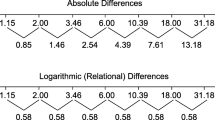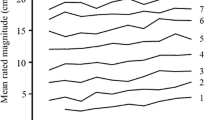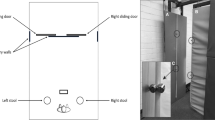Abstract
In Experiments 1 and 2, adult humans were tested on a series of problems which were presented with two-dimensional stimlui. In each problem there were two similar pictures. The pictures contained adults, children, animals, and things. In addition problems an item was added in the second picture; in deletion problems an item was deleted in the second picture. The task was to discover the difference in the pictures. Adult humans solved addition problems significantly more often and faster than deletion problems. In Experiment 3, adult humans were presented with an addition or deletion problem using three-dimensional stimuli. The problem was presented with two versions of a dinner place setting. One version had 15 items, and the other version had 9 items. The task was to try to identify the six added or deleted items. Adult humans found significantly more added than deleted items.
Similar content being viewed by others
References
AGOSTINELLI, G., SHERMAN, S. J., FAZIO, R. H., & HEARST, E. (1986). Detecting and identifying change: Additions versus deletions. Journal of Experimental Psychology: Human Perception & Performance, 12, 445–454.
HEARST, E. (1978). Stimulus relationships and feature selection in learning and behavior. In S. H. Hulse, H. Fowler, & W. H. Honig (Eds.), Cognitive processes in animal behavior (pp. 51–88). Hillsdale, NJ: Erlbaum.
JENKINS, H. M., & SAINSBURY, R. S. (1969). The development of stimulus control through differential reinforcement. In N. J. Mackintosh & W. K. Honig (Eds.), Fundamental issues in associative learning (pp. 123–161). Halifax, Canada: Dalhousie University Press.
LYONS, K., BENTLEY, D. M., HOLLINGSWORTH, C., JERZAK, P., & NALLAN, G. B. (1992, March). Classical conditioning in the rat: Addition/deletion as the conditioned stimulus. Paper presented at the meeting of the Southeastern Psychological Association, Knoxville, Tn.
MIRANDA, N., JACKSON, L. S., BENTLEY, D. M., GASH, G., & NALLAN, G. B. (1992). Children discover addition more easily and faster than deletion. The Psychological Record, 42, 117–129.
NALLAN, G. B., PACE, G. M, MCCOY, D. F., & ZENTALL, T. R. (1979). Temporal parameters of the feature positive effect. American Journal of Psychology, 92, 703–710.
Author information
Authors and Affiliations
Corresponding author
Additional information
Beyond first authorship, the order of authorship is alphabetical.
The authors thank Lori Holloman, Melissa Owens, and Allison Smith for their help in recruiting and testing subjects, and Kathleen A. Nallan and two anonymous reviewers for their critical reading of a previous version of this manuscript. We are grateful to the University of North Carolina at Asheville’s Undergraduate Research Program for their support.
Rights and permissions
About this article
Cite this article
Nallan, G.B., Bentley, D.M., Carr, J.F. et al. Adult Humans Perform Better on Addition Than Deletion Problems. Psychol Rec 44, 489–499 (1994). https://doi.org/10.1007/BF03395139
Published:
Issue Date:
DOI: https://doi.org/10.1007/BF03395139




